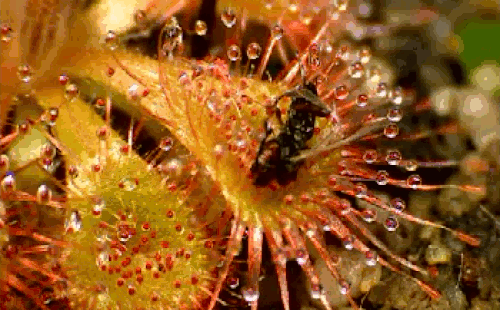The predatory species has the most perfect trap mechanism: Super-long tassel, straight-edged 'mouth' full of acid bait
Drosera glanduligera is a carnivorous plant belonging to the limb genus (Drosera). However, it is only available in Australia and not spread all over the world (except Antarctica) like other species of vines.
Great prime player in the house to catch prey
Originally, the frame was famous for being the wisest prey species. With a thick leaf of tentacles the tentacles hung with super sticky mucus balls, it held on to any small creature that was badly missed.
To lure prey, the frame releases a sweet, enchanting smell. Their leaves are extremely flexible. Immediately after receiving the signal "trapped" from the tentacles, it immediately curled up, wrapped tightly into the body of the gluttonous fool.

Immediately after receiving the signal "trapped" from the tentacles, it immediately curled up, entwining its prey.
After about 15 minutes, the leaf of the vermicelli had squeezed the suffocating prey. From the trunk, digestive enzymes are mobilized, ready to decompose the body. The nutrient mixture is absorbed through the leaf surface into the interior, feeding the other parts of the plant.
As a member of the house, Drosera glanduligera also possesses all these great traps. However, in order to grow better in the Australian environment, it also upgraded its skills, completing a trap mechanism that is not available to you.
The tentacle layer leaves the leaf extremely long and turns on
In Australia, Drosera glanduligera is present throughout Tasmania and Southwest and Southeast. Its seed does not pick up the soil, as long as the root is rooted.
Unlike other types of seeds waiting for warm spring weather, Drosera glanduligera seeds are cold-loving, and must be peeled in extreme cold conditions.
In the winter, while everything is still sleeping, it is freezing through ice, Drosera glanduligera seeds stir. When the spring was just over, it was full of young leaves, ready to grab any prey to satisfy the hunger and thirst.

Drosera glanduligera seeds are cold-prone, must be separated from the shell in extreme cold conditions.
As with all types of frames, the leaves of Drosera glanduligera are as tight as those of slimy tentacles. Any prey who landed on the leaf of a shrine with tentacles like this table also immediately "can not take hold of me" . They were enthusiastically captured by all different short tentacles, and gradually digested.
But different from all kinds of frames, Drosera glanduligera leaves also possess a layer of tentacles super long outer edge possessing extremely unique turning mechanism. They reach as far as possible, increasing the range of prey to the trunk. As long as the bad guy accidentally touches it, he is immediately caught, speeding right into the center, where all the tentacles are waiting.
The power of the outer tentacles is so strong that it is possible to break after the blow. The price is not very expensive, because Drosera glanduligera can regenerate them.
Tree one year, only once a flowering fruit and then die
During the spring-summer season, Drosera glanduligera actively traps, catches insects, nourishes fattening body. Starting from around August, it grows like a fat, bud-like bud.

Drosera glanduligera reaches the highest size, up to 6cm.
Over time, flower buds grew larger, eventually taking turns sprouting gorgeous orange wings. Also during this time, Drosera glanduligera reached the highest size, up to 6cm.
By around November, Drosera glanduligera fruit was ready to enter the seed. The trap leaves fade away, followed by the branch holding the fruit.
On the ground, Drosera glanduligera seeds patiently waited for the winter to reach the coldest level. Soon, it will sprout, then spread out the round leaves of the tentacles classed in the outer ring like a thin, green flower.
- Discover scary carnivorous plants in Canada
- Video: Lost in the world of carnivorous plants
- Antioxidant is a double-edged sword
- Prevent tooth decay
- Autralia welcomed the first 2-sided cat
- The strongest acid in the world: 10 million billion times more than 100% concentrated sulfuric acid
- Detecting long tail bugs under the ground with cheese bait
- How to give emergency first aid to people suffering from acid burns
- Curved legs turn into straight legs: It turns out people have suffered this much
- What is acid rain? How are the effects of acid rain?
- Folic acid may help prevent cleft lip and cleft palate
- What is folic acid and in what food?
- 6m long crocodile fish bait in Australia
- How to handle when the body is exposed to acid
 Why do potatoes have eyes?
Why do potatoes have eyes? 'Tragedy' the world's largest carnivorous life: Death becomes ... public toilet
'Tragedy' the world's largest carnivorous life: Death becomes ... public toilet Tomatoes were once considered 'poisonous' for 200 years
Tomatoes were once considered 'poisonous' for 200 years Detecting microscopic parasites on human face
Detecting microscopic parasites on human face